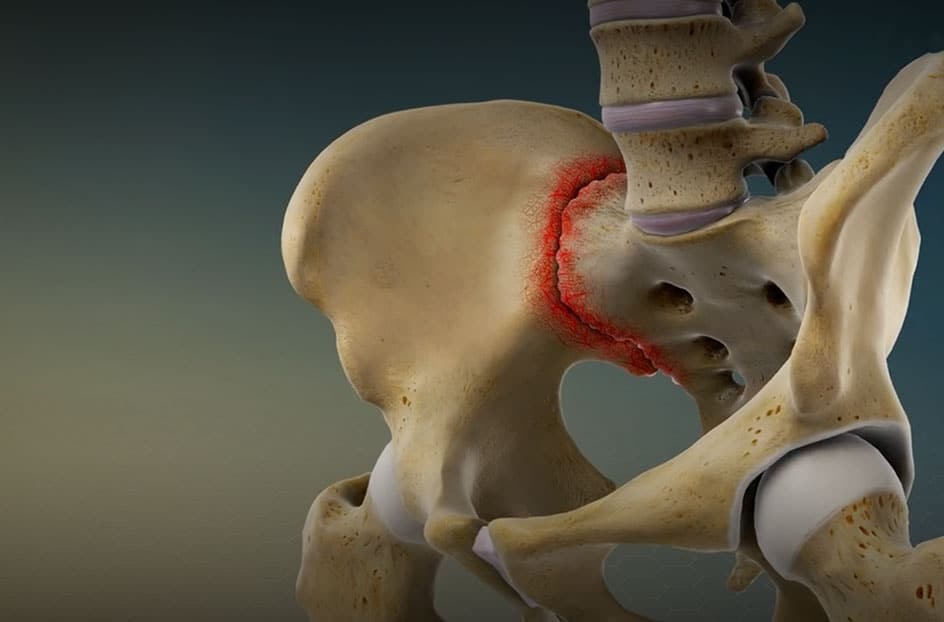Sacroiliac (SI) Joint Pain Treatment
The sacroiliac joints (SI) connect the bones of the ilium, or hips, to the sacrum, a fusion of five vertebrae that holds the pelvis and spinal column together. They are a common source of buttock and lower back pain, with symptoms similar to sciatica.
The sacrum is important for motion, strength, and balance. The sacroiliac joints, located on the right and left sides of your lower back, are unusual in that they are one of the few joints in the human body without motion.
Sacroiliitis is an inflammation of the SI Joint which can cause it to move unnaturally and generate pain.
Recent studies have shown that as much as 35 percent of “non-operative” back and leg pain is actually sacroiliitis, which can be difficult to diagnose because its symptoms are similar to many other common sources of back pain.
Dr. C.J. Berg works closely with patients to identify the source of their pain and discomfort and seek solutions for resolving chronic neck and back issues. A board-certified neurosurgeon, with more than 8 years of experience in military leadership positions (including neurosurgical consultant to the U.S. Air Force Surgeon General), and a Healthcare MBA, he approaches each situation with a broad knowledge base and a commitment to beginning with the least aggressive, and most effective, treatments possible.
Diagnosing Sacroiliitis
Sacroiliitis is often a diagnosis of exclusion:
- Patients often have the same symptoms as sciatica, or a disc herniation with pinched nerves.
- Many of these patients have been told they have “non-operative” back pain, after they’ve seen several surgeons and have had a lower back MRI that doesn’t show anything.
- Dr. Berg will try a number of maneuvers to try and stress the joint and reproduce the pain.
- If Dr. Berg suspects that back and leg pain is generated by the SI joint, he will prescribe a sacroiliac joint injection, which is a combination of topical anesthetic and steroids.
- If the SI joint injection provides more than 75 percent pain relief, a patient may be a suitable candidate for an SI joint fusion.
Contact Dr. Berg’s office today to learn more about treatment for SI joint pain and schedule a consultation.
SI Joint Fusion Surgery
Once you’ve found the cause of a patient’s previously undiagnosed pain you can treat it. The long-sought after relief can be quite dramatic.
An SI joint fusion is a 20-minute outpatient surgery:
- Dr. Berg uses a drill to “injure” the joint, stimulating the body’s natural healing response, and insert three bone wedges.
- Patients go home the same day.
- As the bone heals, and new bone grows across the joint, it will stabilize it and eliminate pain.
- Within 6-8 weeks, most patients are pain-free.
Recovery (6 weeks):
- Light activity
- Lifting restrictions
- Nothing more strenuous than a brisk walk
Sacroiliac (SI) Joint Pain Treatment in Columbus, Ohio
Dr. C.J. Berg is a board-certified neurosurgeon with a mission to revolutionize the way spine health is viewed, managed, and treated. He is committed to getting to the root cause of chronic neck and back pain so that he can diagnose accurately and treat effectively, utilizing the least invasive surgical (and nonsurgical) techniques and the most advanced recovery methods to allow patients to get back to living their lives as soon as possible. To schedule a consultation, please call (614) 468-5333 or book an appointment online.

SI Joint Dysfunction Symptoms
What does sacroiliac joint pain feel like?
- It may feel like a sharp, stabbing pain that radiates from your hips and pelvis, up to the lower back, and down to the thighs.
- It may feel numb or tingly, or as if your legs are about to buckle.
- While the pain associated with sacroiliitis most commonly occurs in the buttocks and lower back, it can also affect legs, groin and feet.
Sacroiliitis pain may be aggravated by:
- Standing for a long time
- Bearing more weight on one leg than the other
- Climbing stairs
- Running
- Large strides
Causes for Sacroiliac Joint Dysfunction
- Traumatic injury – A sudden impact, such as a motor vehicle accident or a fall, can damage your sacroiliac joints.
- Arthritis – Osteoarthritis, caused by wear and tear, can appear in the SI joints as ankylosing spondylitis, a type of inflammatory arthritis that affects the spine.
- Pregnancy –Pregnancy weight and altered gait can put stress on the SI joints that leads to abnormal wear. The sacroiliac joints must also loosen and stretch to accommodate childbirth.
- Infection – In rare cases, the sacroiliac joint may become infected.

